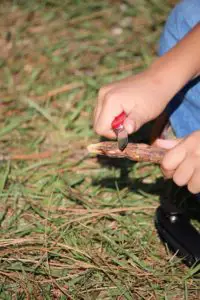The renowned artist and sculptor Michelangelo is well known for saying that every block has a statue inside of it, and it is the task of the sculptor to discover it. He described the process of carving angels as “setting them free” from the material that they were trapped inside. While Michelangelo was referring primarily to carving stone, the same sentiment can be applied to whittling and wood carving.
Each block of wood contains an endless number of possibilities. It is up to you to decide which one of those possibilities will emerge from that material as a work of art. When you choose a creative vision and set it free from the wood which imprisons it, well… anyone who gets a taste of such a primal creative force will be hooked for life!
What is the difference between whittling and wood carving? This is a very common question. The two are very closely related. The general view is that whittling is the act of carving wood while using only a straight edge knife while wood carving involves using a wider assortment of tools to reach the desired outcome.
Whittling
Again, in its simplest form, whittling can be as little as carving a piece of wood with nothing more  than a knife. There are many purists out there who would only ever consider using a folding pocket-knife to accomplish their task, others use gauges, sand paper and fixed blade knives as well when at home. All you need to get started, however, is a piece of wood, and sharp knife.
than a knife. There are many purists out there who would only ever consider using a folding pocket-knife to accomplish their task, others use gauges, sand paper and fixed blade knives as well when at home. All you need to get started, however, is a piece of wood, and sharp knife.
An often-overlooked segment of whittling and carving is the fact that you must keep the tools you are using sharp. This means a sharpening stone, a strop, and stropping compound.
A good pair of gloves to protect your hands is also a good idea to use as well in case the blade should slip. The gloves should be worn at all times, both when you are carving and when you are sharpening your tools.
Wood
When you’re just starting out, it’s important to choose your materials wisely. The better the quality of your materials, the easier it will be for you to be successful. In the case of wood, you would do well to start with soft wood. A few classic examples of soft wood which are often used for whittling projects include pine, basswood, and balsa.
These types of wood will not only be easier to cut and hone your skills on, but they will also be gentler on your knife, requiring less breaks to re-sharpen or re-strop your cutting edge.
Also, the easier the wood is to cut, the more control you will have, meaning you will be more precise and less likely to cut yourself as you try to force the blade through.
Knives
What knife should you choose when getting started with whittling? You don’t want anything too long; generally, the shorter the blade is, the better. Depending upon your preference, you could pick up a specialized whittling knife or a general all-purpose pocket knife. If you’re just starting out, make your choice based on availability, comfort, and budget. Other than that, most anything will do.
As you begin looking at difference knives to find the best one for you, you’ll see that blades typically come in two metals – high carbon steel and stainless steel. High carbon steel is used more often. Stainless-steel is a great material as well, just keep in mind that it takes longer to sharpen.
Something I always recommend for people new to whittling or carving is to get a fixed blade knife when starting out. This is just an additional safety precaution to avoid having the knife blade closing on your finger unexpectedly. If you are looking at whittling, I’d recommend this particular knife. At the bottom of this article I’ve included a link to my recommended beginner’s woodcarving tool sets. Whittlers will be interested in seeing the page too for the safety and sharpening tools that I recommend.
Sharpening
As for sharpening equipment, there are many options out there, but be sure to use quality tools since you will be using them often. There are many videos available that can teach you how to properly use a sharpening stone and a strop. Don’t skip this step. Many first-time whittlers ignore this part of the process and end up giving up the hobby because of it.
When working with a dull knife it is much more difficult to control your cuts, which leads to frustration, blisters, tired hands, and sometimes a bit of blood. Working with a sharp knife is smooth, easy, meditative, and most of all, safe! If you want the true whittling experience, sitting deep in thought, stepping outside of time, breathing in rhythm with the universe which surrounds you… then keep that knife sharp!
How do you know your knife is sharp enough? Here’s a good trick I learned from an old-time whittler: try to shave a few hairs off one of your knuckles. If they come off fast, smooth, and easy, then your knife is as sharp as a razor and ready to go! Oh, and don’t worry about the hair, it’ll grow back!
Beginner Projects
Once you have picked out a piece of wood and found a blade, you need a project! The most important thing to consider when choosing a project is that it is meaningful to you in some way. I began my journey into the world of whittling by carving simple wood-spirits. These are mythical, bearded figures who are said to reside in the forest. It is surprisingly easy and extremely rewarding once you get the hang of it. Plus, there are several tutorials easily found online which walk you through the cuts step-by-step.
Other easy beginner projects include animal shapes, objects (boots), symbols (hearts), or even basic chess pieces! Once you gain a bit of confidence, encourage yourself to make each project your own. Make slight changes in the design, project by project, until you have something unique which you have created.
Another step which many whittlers choose to take is painting their finished pieces. This is a fantastic way to add detail, color and life to your project. A little sanding to make the wood smooth and sealer such as mineral oil, will easily prepare your piece for painting. A finished, painted piece can be beautiful and eye-catching, but the simplicity and charm in an unpainted piece holds a power all its own.
Wood Carving
Whereas whittling is specifically the process of holding a piece of wood in your hand and shaping it with a knife, “wood carving” is a more general term. In fact, whittling is a type of wood carving! The umbrella term “wood carving,” however, allows for a much greater variety in techniques, tools, and projects.

After graduating from the pocket-knife, the aspiring wood carver would now be introduced to all manner of new tools. Obtaining a set of carving chisels and a good mallet is a great first step. Sand-paper, if not being used already, will certainly help refine rough edges at this stage and create a polished look. A set of gouges would be useful for adding finer detail while helping you save time. Even power-tools can be used to get the job done!
As with most hobbies and such, there are many options available to expand and grow your carving techniques. While purist whittlers and carvers may wish to only use the more primitive carving tools available, there’s a whole other group of carvers who incorporate power tools into their carving. In fact, it’s not uncommon to find people who use Dremels and angle grinders to create their pieces. In mountainous areas, it’s also common to find carver who use chainsaws!
As you increase the power within the tools you use, you open the door to more types of wood that you can use. Once you start using power tools to carve, you are no longer limited to softwoods.
For a more detailed article on getting started with wood carving, check out my article here.
Additional Differences
In addition to the ever-greater assortment of tools and types of wood at the wood-carver’s disposal, the process of carving allows for larger pieces to be fashioned. A vise can be used to hold medium sized pieces of wood in place giving the wood carver more freedom of movement and both hands to work with. Even large, free standing slabs of wood can be worked using wood carving techniques.
A whittler might carve chess pieces, while a wood-carver might carve the chess board itself. A whittler might carve a small hand-held wood spirit out of a piece of pine-wood, while a wood-carver might use part of a fallen oak tree to carve a life-sized wood spirit, hidden under the bark! These comparisons only scratch the surface of the potential hidden beneath the facade of these two art forms.
Closing
Whether you choose to enter the world of whittling or wood carving, there is one thing you should keep in mind – you will make mistakes! As with every other aspect of life, mistakes are part of the process of learning. Your first few creations will be a little rough around the edges. They might be a bit unsymmetrical. You might cut against the grain of the wood splitting and ruining one section of your piece. You might be overzealous making the nose perfectly even and realize too late that there is no nose left! Each mistake that you make will be a mistake you will not make the next time around. Before you know it, you will be whittling and carving pieces that you are proud of.
You will give many of your creations away as gifts, leaving part of yourself with each person who enjoys your art. You might even, someday, consider selling one of your works! Every journey begins with a single step.
Ultimately it is up to your interest and curiosity to take you further into the fascinating world of whittling and wood-carving.
One piece of advice I always give people who are new to this form of art is this: relax, take your time, go slow. If you are constantly tense or frustrated, then you are doing it wrong. When you are focused on a goal and you feel the wood coming away in smooth slices, revealing more and more of the creative vision which you have chosen manifest, time slows down, life’s hectic cares seem a million miles away, peace creeps into the world of human drama, and at the end of it all, you have a work of art which you have discovered inside of your creative soul, and set free from its block of wood.
Recommended Beginner Tools
Looking for your first tools as a wood carver can be overwhelming. Once you purchase the tools, it’s easy to second guess your decision wondering if you made the right decision. Since there are so many tool options available, I put together a list of tools carving tools for a beginner that I’ve found to be a great balance between quality and budget. You can pick up everything on my list for under $150 and be carving within just a few days. To find my list of recommended tools, visit this page.




